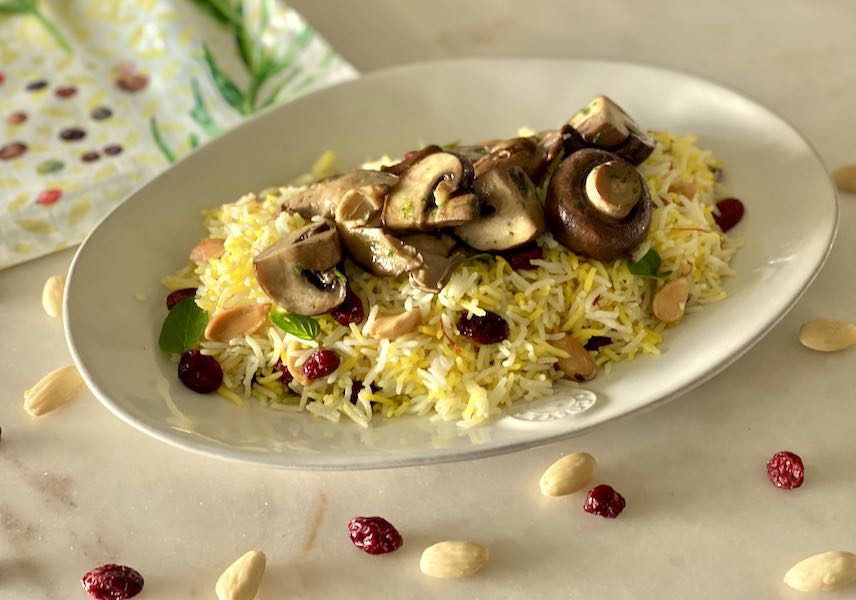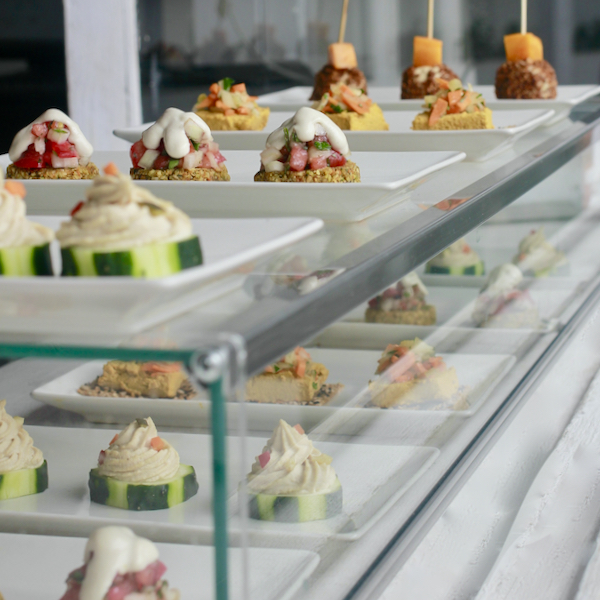
Do you have Saffron in your pantry? Maybe a little transparent box with a few (laughs) red strands inside? Keep it well, it is a treasure and has been so throughout history. Traditional cuisine has reserved it for special occasions, party dishes, celebrations. It couldn’t be any other way due to its high price and the golden color it gives to food.
In Eastern Mediterranean, jeweled saffron rice (decorated with pistachios, almonds, raisins, pomegranate, orange peel and apricots, among others) is a must at a wedding. Today we show you how to prepare a simpler version to accompany a mushroom stew and see the saffron technique. Then, you can increase the level of sophistication until you create your own ideal jeweled rice.
Saffron is a powerful colorant and we aim at a loose, two-color rice where golden grains are combined with white grains to accentuate the dish colourful look. The technique is very simple and you can read it in detail in the recipe at the end of the text. In the photographs you can see the three key steps:
2. Cook the basmati rice in a pot with a lid. We cook it with the same amount (in volume) of broth as rice and with the lid on. After ten minutes of cooking we turn off the heat and pour the saffron infusion over a quarter of the surface (see photo). We cover the pot and let it rest for another ten minutes. In this way, we obtain a part of golden rice grains and another part white, obtaining a loose-grain bicolor rice.
3. Once the time is up, we transfer the rice to a large, open container and mix it well, aerating it so that it loses the water vapor. It is now ready to add our jewelry: herbs, nuts and fruits if we want.

In the picture you can appreciate the beautiful effect of two-color rice. Between the grains you can see the saffron threads, which have now been integrated into the dish. By washing and cooking the basmati rice to perfection, we obtain loose white and golden grains that will serve as a base for complements of different colors, flavors and textures. Today: almonds, cranberries and mint leaves.
In our case, we top the rice with a mushroom stew, Portobellos and Shiitakes that blend with the flavor of saffron very well. If we want a more festive look we can add toasted pistachios, pieces of dried apricots, candied orange peel and fresh pomegranate seeds. The variations of the dish are endless since we can add fried whole spices (cumin, coriander, mustard) and turn it into an Indian Pulao or a chopped fresh herb mix (parsley, mint) and treat it like a Turkish Pilaf.
In our recipe we focus on the flavor and aroma of saffron contrasted with toasted almonds and cranberries. The mint gives it fresh notes and the sautéed mushrooms make us enjoy every bite. It is a happy dish, very attractive and that makes us dream of parties and celebrations.
- 250 gr Basmati Rice
- Vegetable broth
- 1 teaspoon saffron threads
- 40 g dried cranberries
- 50 g peeled almonds
- Extra Virgin Olive Oil
- Sea salt
- Black pepper
- 1 sprig of fresh mint leaves
- 200 g fresh mushrooms mixed (Portobello, Shiitake, or other varieties)
- 1 teaspoon cornstarch
- 1 sprig of fresh parsley
- Wash the rice in a bowl of water several times until the water is clear. Rinse and reserve in a strainer.
- Infuse the saffron with three tablespoons of warm water in a cup. Soak cranberries in a bowl.
- Heat three tablespoons of oil in the pot where you will prepare the rice. Over very low heat, fry the almonds until golden. Remove them, leaving the oil in the pot, reserve on a plate with kitchen paper and lightly salt them.
- Pour the rice into the pot and over very low heat, stir until the grains are well coated with the oil. Add the broth (the same amount by volume as rice) and a pinch of salt and bring it to a boil over high heat. As soon as it starts to boil, lower the heat to minimum and cover the pot with the lid. Let it cook for 10 minutes.
- Remove the lid and pour the saffron infusion with the strands over a quarter of the surface of the rice (see photo). Cover again and let it rest without heat for another 10 minutes.
- While the rice is cooking, sauté the mushrooms in a frying pan with two tablespoons of oil over medium heat. When they begin to sweat add 100 ml of broth and a teaspoon of cornstarch. Mix well and let it cook over low heat for five minutes. Season with salt and pepper, sprinkle with chopped parsley and set aside.
- Put the rice in a large bowl and with a spatula mix the white part with the golden part well. Let the steam air out well and add the almonds and cranberries. Mix well again.
- Serve in a flat dish placing the mushrooms on top of the rice. Decorate with fresh mint leaves.











Leave a Reply